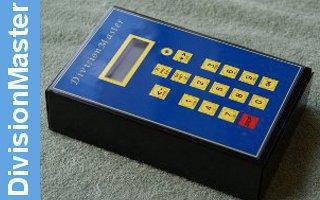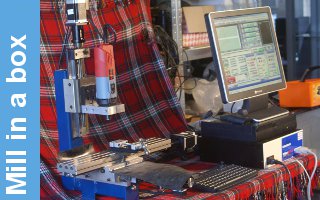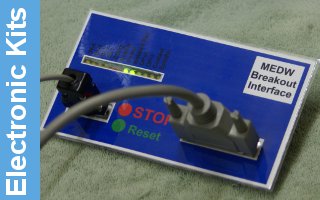HRP Front Fork
For the front fork (Burrell) there is a casting which should be held in the four jaw chuck so as to machine the parallel spigot first, making sure that the top of the fork is held central in the chuck, i.e.: turn the chuck by hand and make sure that the corners fall in line, with the turning tool used as a guide. After the shank has been machined parallel, it will then be an easy matter to mill through the inside of the fork. In the absence of a milling machine, the fork could be milled in the lathe with the help of a vertical milling slide, being a fairly straightforward component to clamp down. Undoubtedly these sort of operations are often carried out with a file in the absence of better equipment, there is no real reason why this should not be done perfectly well, with care.
The front fork of the Fowler Showman's engine should be set up and machined in a similar manner to that of the Burrell, where a casting is available.
The equivalent component in the Simplicity Roller is called the uprighting stud, and is machined as follows:-Hold the main shank in a three or four jaw chuck, as necessary to centralise the main casting, and then just skim over the chucking spigot until it is cleaned up true. It will then be an easy operation to grip this spigot in a three jaw chuck, while a centre drill in the tailstock chuck is used to machine a centre in the main shank. The turning of this shank can be considerably simplified by carrying the smaller top diameter right down to the point at which the lower and larger bearing step commences, machining a square shoulder at this junction instead of joining the two bearings with a long taper. The machining of the bore of the saddle bracket will constitute a simple stepped bore to house the two stud diameters. Before machining the bore of the uprighting stud, it will be wise to make the fore-carriage joint pin. This is a fairly straightforward machining operation, the parallel diameters being taken care of first, and then the top slide being set over to achieve the necessary angle for the tapered section; leaving the top slide set at this angle, it will then be possible to machine a 'D' bit out of a piece of silver steel to make the cutter to ream a tapered bore in the uprighting stud. After turning the silver steel blank for the 'D' bit, it should be finally polished with emery cloth to remove any lines. Next mill or file half of the diameter away, carefully stoning the edges, but being sure not to remove the cutting edge, or to reduce the diameter at this point (see drawing No. 13). Note the clearance flat which is filed just below the cutting edge of this tool. When the 'D' bit has been fully machined and polished, it will need hardening and tempering. Proceed as follows:-Heat the tool gently until it is of an even cherry-red colour all over the working area of the cutter; then plunge into clean cold water. It will now be extremely hard and brittle. Clean the face of the tool with emery cloth so that bright steel is visible. To temper this 'D' bit, it is necessary to heat it slowly and evenly until the whole of the cutting area becomes of an even mid to dark brown colouring. This is easy enough to achieve if one has access to a hardening oven; however, few modellers will have access to this luxury, and therefore we will use other methods. A tool with a shank of reasonable length and with the cutting section relatively short can be effectively tempered by playing a flame on the lowest part of the shank, and allowing the heat to gradually rise up the tool until the tempering colours start to appear. Naturally the top of the tool will be cooler, but provided the difference in the temperature is not too marked, an even colour of brown can be achieved, and at this point the 'D' bit should be plunged in cold water. On consideration of the method just described, the reader will realise the limitation if the cutting section of the tool is relatively long (i.e.: !"-!£") and is fairly thin; it will be virtually impossible to produce an even colouring throughout the tool. With practice, it is possible to watch the colour climbing, and then to apply heat to the top at the critical moment to produce the even colouring and heat you require. A further method is to fill a small tin box with sand, and to lay your 'D' bit well down into this and then heat the box on a gas ring. The sand maintains an even heat throughout and produces a tool of constant hardness. Incidentally, a sand box is also ideal for tempering springs.
Returning to the uprighting stud, a pilot hole can be drilled, followed by the 'D' bit, making sure that the stud is clamped down square during this operation; the 'D' bit should be used at a low speed to produce the best finish. Turn up a suitable spigot in the lathe on which to mount the uprighting stud while facing off the end flanges to the bore. N.B.: The holes in the arms of the uprighting stud should not be drilled until assembly with the front fork is carried out. 'SIMPLICITY' FRONT FORKThis is a very straightforward casting to machine. The locating slot for the uprighting stud merely needing cleaning with a file. The bosses at the end of the fork should be carefully centred with a punch, and then a pilot hole drilled in each end, after which a drill may be held in the three jaw chuck and each end of the fork drilled while the other end is supported by the tailstock centre. Now, open up the holes with a reaming size drill, and follow up by reaming to the finished size (of course, supporting between the centre at each stage). It will now be necessary to make a pilot facing cutter as in the drawing No. 27. When using this cutter in the three jaw chuck, run the lathe slowly, and supporting the other end of the fork in the tailstock centre while using the tailstock as a feed, you will produce a good finish. The outer faces can be machined in this manner, but to face the inside of the fork bosses, it is practical to reverse your facing tool in the pilot holder after passing this through the bore, so that the tool is on the inside; the same basic procedure is used, except that it will be necessary to make some simple clamping device to hold the fork back onto the tailstock centre during the cut, since this centre will be Amoving away from the chuck during the facing operation.
The bores for the main swivel or joint pin may be drilled and reamed out easily enough under an ordinary drill press. Hold this fork carefully in a machine vice, packing if necessary to hold the casting square. The holes for the swivel locking pins should be carefully marked out and then drilled in the fork, after which the uprighting stud should be pinned in position and locked in the upright while the holes in the fork are used as pilots to drill the arms of the stud. FRONT ROLLS SIMPLICITY:-Machining of these will need to be carried out on a fairly large lathe, access to which may often be obtained by attending local evening classes. The main consideration when machining these is to ensure that both the front and the back of the casting runs true, I cannot emphasize the back too strongly, since castings of this nature are often spoilt because the back is not taken fully into account. It should be borne in mind that the inner edges of the rims of the rolls are not turned; all that is required is a small angle cut at approx. 25 degrees to just clean the edge true, this being carried out on both sides of the roll.
Turning of the face of the rolls can be carried out as quickly as possible, with the work running slow, but employing a very coarse feed. When the original rolls were turned they had almost a thread as a finish, this would cut down machining time but also probably help to prevent side slip, during the initial stages of use, therefore a lined finish on your rolls is correct; the edges of course, should have a normal finish, after which the angle cut is carried out.
Probably the most difficult machining on the rolls is the long, small bore; at first glance, the axle for the front rolls would appear to be ridiculously small, however, in this particular design the rolls considerably helped to support the axle itself, due to the long and widely spaced bearings. After all the heavy machining has been carried out on the O.D.'s of the rolls then the bore should be machined (NOT the other way round), thus keeping the job true. Drilling and reaming of the bores is a careful job and one which can easily go wrong. Generally speaking too much faith is put in the centre drill; this is best used as a tool to produce a location for the lathe centres for which it was mainly intended. One often sees an attempt to produce an accurate hole simply by starting with a centre drill and following through with a standard two-flute drill, invariably resulting in a hole which goes well out of true. There are various imethods of producing an accurate hole and of course the smaller and longer the bore, the more difficult it becomes, since it is not possible to use a boring tool. It is practical to grind a suitable drill so that it is absolutely central, ithen thinning the centre web at the point, so that the drill does not try to avoid cutting and can bite immediately at the centre (see Drg. 14). On commencement of drilling steady the side of the drill as it first enters the work, by ibringing the lathe turning tool against the side of the drill, as close as possible to the face of the work to be drilled. Once a drill has been correctly started in this manner it should continue to drill true, if ground centrally; ihowever, this method is not infallible since the uniformity of the iron in the bore can sometimes vary, in which case a drill may wander. Should a bore run out of true it can generally be corrected by the use of either a flat bottomed idrill or a 'D' bit, these have no angle at their cutting edge and are therefore influenced very little by the 'out of truth' of a bore, provided the start was absolutely true.
iA method used by the writer for producing a series of 3/16" diameter holes 11^" long is described. First take a drill just smaller in diameter than the size of the deep hole and, using the lathe tool as a steady drill in for ". Now iuse a small boring tool to bore this pilot hole to take the 3/16" drill exactly (there must be no play whatsoever). Now use a standard length 3/16" drill and enter this into the bored pilot hole. Providing this drill has been ground central it should continue to its full depth, after which the long drill can be inserted to finish the job. Of couree there are sophisticated additions one may employ when drilling extra deep holes of small diameter (the writer did in fact use a quick-retracting drill holder so as to withdraw the whole length of the drill, to quickly clear the swarf; the holder was incorporated with a slipping clutch between the tailstock chuck and the drill itself, so that if a jam occurred the drill would slip, but not break). Finally the bore of your rolls may be finished with a reamer or 'D' bit, or even a drill with the leading edges carefully stoned, this will produce a fine finish if the drill is fed in slowly.
In industry, three and four flute drills are often used for producing long, true holes; they have a definite advantage over the common two flute drill, since with the cut being taken at several points around the circle any tendency to kick sideways is removed. However, I mention this purely out of interest since model engineers are unlikely to be this well equipped.
'SIMPLICITY' (OIL HOLES) in the rolls must be achieved by drilling first through the main rim of the roll and then using a long drill to make the oil hole in the hub itself. A long drill for this purpose can be made by taking the necessary drill, turning down the shank and setting it into a drilled hole in a piece of rod; it can then be secured with solder or pinned, since the end of the drill is normally soft enough to machine. Oiling of the rolls is of course carried out through a large cast hole in the outer face of the roll. 'SIMPLICITY' STEERING SEGMENT BRACKET. This can be packed up on the face-plate and clamped, or carefully located in a four jaw chuck, drilling and boring can then be carried out and the first side of the boss faced off; after this reverse onto a tapered spigot and then face the other side to length. With a piece of steel stock held in the three jaw chuck, machine a parallel spigot to take the bore of the bracket; this should end in a sharp step at the back and a suitable thread at the front, so that the bracket is securely locked while the location to take the bronze worm wheel segment for the steering is machined.
The AXLE CENTRE for the BURRELL is a straightforward machining operation already covered by the foregoing machining hints. The Fowler Showman's engine has no axle centre since the axle fits direct into the fork; this axle can be made as follows:-Take a piece of flat steel bar of suitable size for the thickness and depth of the main axle beam, this excluding the radiused contour around the slot for the swivel pin. Turn the ends of the shafts (i.e.: the location for the wheel bearings) carrying out this machining in a four jaw chuck or between centres. Now make two round collars to slip over the shafts to give the correct section when blended to the main axle by brazing. The centre contours of the axle will be obtained by making a separate piece and brazing on neatly. A flamecut can be used to give the complete contour of the axle in one piece if preferred.








